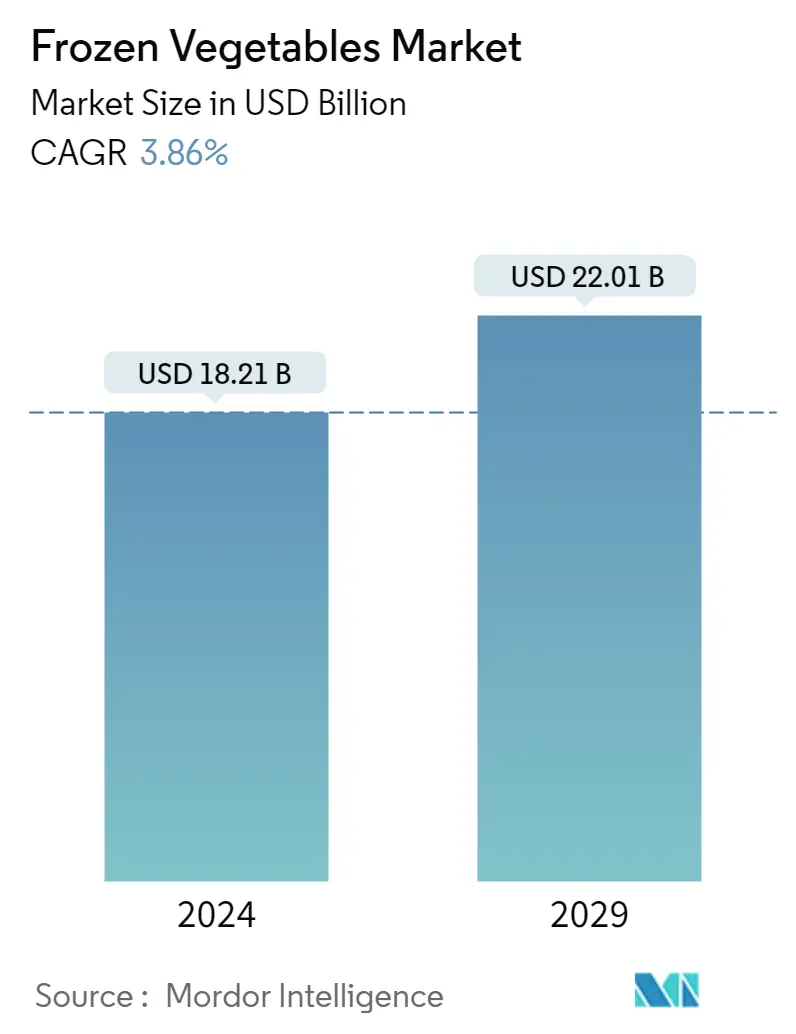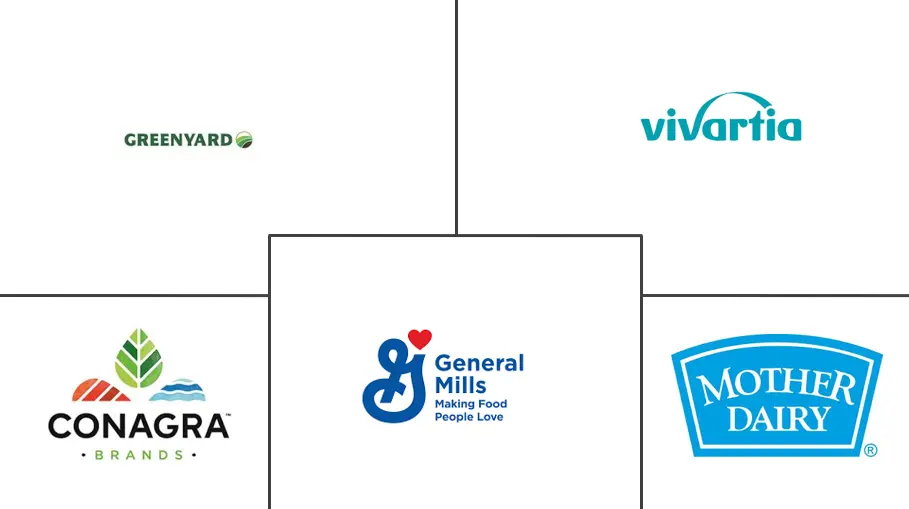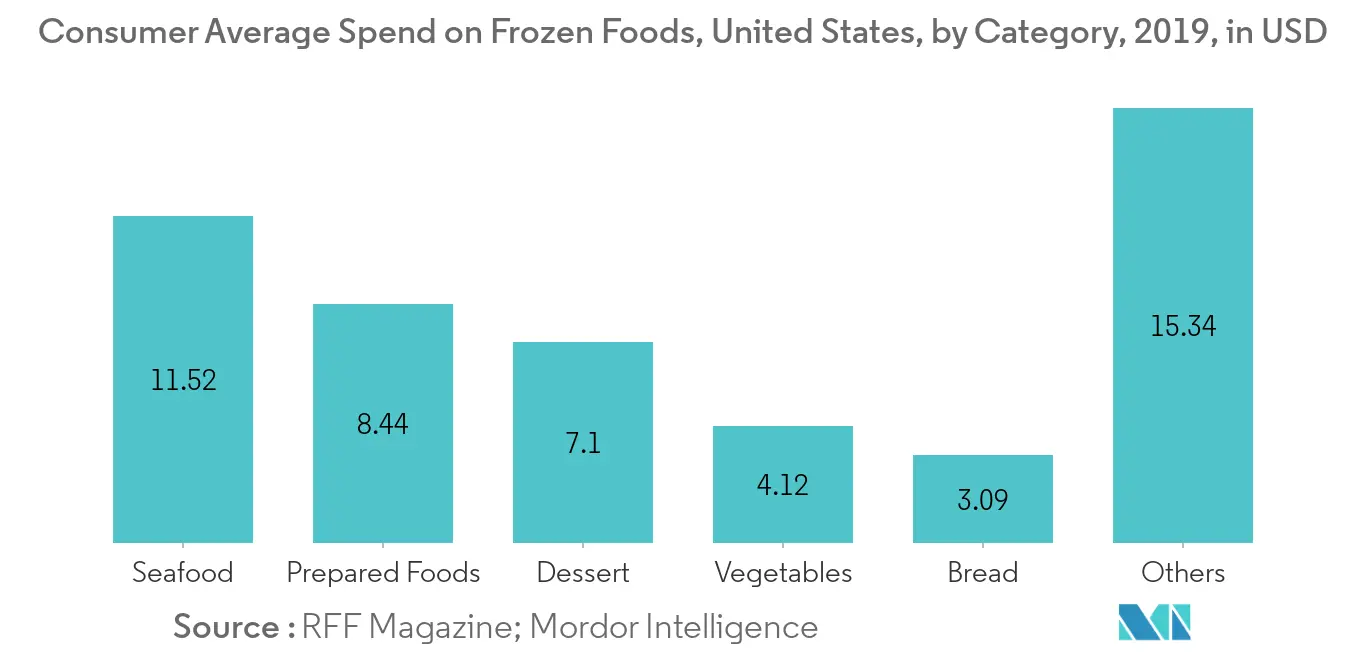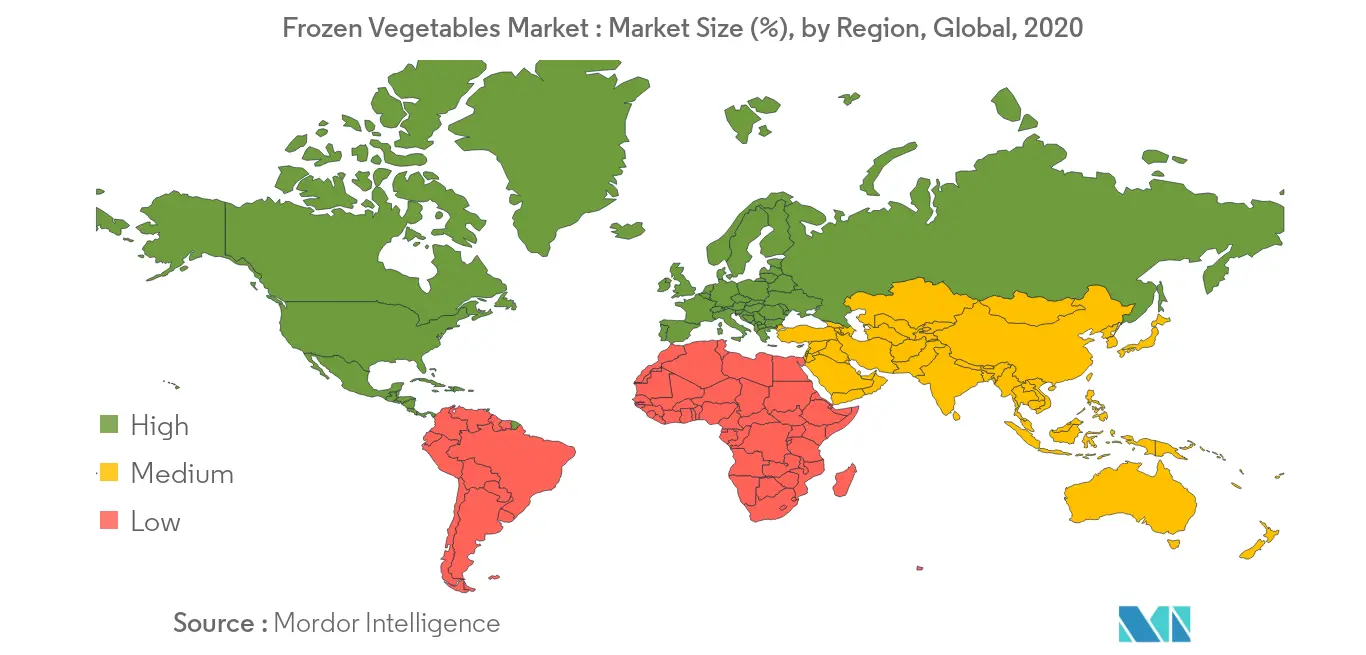Frozen Vegetables Market Size

| Study Period | 2019 - 2029 |
| Market Size (2024) | USD 18.21 Billion |
| Market Size (2029) | USD 22.01 Billion |
| CAGR (2024 - 2029) | 3.86 % |
| Fastest Growing Market | Asia Pacific |
| Largest Market | Europe |
| Market Concentration | Low |
Major Players
*Disclaimer: Major Players sorted in no particular order |
Frozen Vegetables Market Analysis
The Frozen Vegetables Market size is estimated at USD 18.21 billion in 2024, and is expected to reach USD 22.01 billion by 2029, growing at a CAGR of 3.86% during the forecast period (2024-2029).
- The rapid pace of urbanization, especially in the developing economies, coupled with growing disposable income and rising influence, has allowed convenience products to take center stage with regard to different fruits and vegetables. Altering technological advancements, along with aesthetic packaging, ease of storage, and all-around availability, are boosting the demand for frozen vegetables. The presence of well-balanced cold chain solutions and connected retail outlets have led to dramatic sales of the market, where most of the product portfolios are largely catered by local mid-and small-sized farms.
- Furthermore, this segment is gaining popularity as a preferred alternative to fresh, canned, and cooked food and healthy snack options among the millennial populations in the market.
- Due to the COVID-19, the frozen vegetable market has been performing well following the onset of the novel coronavirus. The fact that frozen vegetable is able to retain the nutritional value for a long period, and in turn, this helps bring down the number of times consumers have to visit the shop or outlet, which also works in favor of the market. Although the COVID-19 impact on the cold chain supply has been significant, the evolving buying patterns of the consumers with more inclination towards health have helped the frozen vegetable market develop faster than expected.
Frozen Vegetables Market Trends
This section covers the major market trends shaping the Frozen Vegetables Market according to our research experts:
Increasing Demand for Convenience Food Products
Since, globally, the younger population (particularly from the developing countries like India and China) is actively engaged in various professional commitments, they are increasingly looking for food products that can be stored and instantly eaten, also with more shelf life. Therefore, working millennials prefer to buy frozen veggies in order to decrease the vegetable cutting and buying time on a regular basis. On the other hand, the surge in demand for frozen vegetables seems to be more favorable for products that are convenient to eat and prepare as well. A study analyzed by RaboBank states that the import of frozen sweet potatoes in the European Union, particularly from the United States, has tripled over the last four years, hence, citing the level of consumer favoritism in devouring the product.

Europe Holds a Significant Market Share
Demand for convenient meal solutions among time-pressured European consumers has been witnessing a continuous increase, which is pushing the market growth of frozen vegetables in the European region. Furthermore, with strong purchasing power and sophisticated consumers, in general, the Europeans tend to mirror the food trends of the Americans. Increasing consumer spending on eating out, especially the younger consumers are spending more on eating than an average, will further boost the revenues in the European frozen vegetable market. Consumers in the region are becoming inclined toward vegan and healthy food as a part of lifestyle change. There has been a considerable shift from high-fat food products to low-fat and high-protein vegetables and fruits. Hence, this is boosting the market growth.

Frozen Vegetables Industry Overview
The frozen vegetables market is a highly fragmented market and comprises regional and international competitors. The market is dominated by players like General Mills Inc., Conagra Brands, Pictsweet Farms, Mother Dairy Fruit & Vegetable Pvt. Ltd, and ITC Brands, among others. Companies compete on different factors, including product offerings, ingredients, quality, price, functionality, size, packaging, and marketing activities, in order to gain a competitive advantage in the market. Key players are now focusing on social media platforms and online distribution channels for their online marketing and branding of their products to attract more customers.
Frozen Vegetables Market Leaders
-
Conagra Brands
-
Mother Dairy Fruit & Vegetable Pvt. Ltd.
-
Bonduelle Group
-
ITC Brands
-
Earthbound Farm
*Disclaimer: Major Players sorted in no particular order

Frozen Vegetables Market Report - Table of Contents
-
1. INTRODUCTION
-
1.1 Study Assumptions and Market Definition
-
1.2 Scope of the Study
-
-
2. RESEARCH METHODOLOGY
-
3. EXECUTIVE SUMMARY
-
4. MARKET DYNAMICS
-
4.1 Market Drivers
-
4.2 Market Restraints
-
4.3 Porter's Five Forces Analysis
-
4.3.1 Threat of New Entrants
-
4.3.2 Bargaining Power of Buyers/Consumers
-
4.3.3 Bargaining Power of Suppliers
-
4.3.4 Threat of Substitute Products
-
4.3.5 Intensity of Competitive Rivalry
-
-
-
5. MARKET SEGMENTATION
-
5.1 By Type
-
5.1.1 Beans
-
5.1.2 Corn
-
5.1.3 Peas
-
5.1.4 Mushroom
-
5.1.5 Cauliflower
-
5.1.6 Asparagus
-
5.1.7 Broccoli
-
5.1.8 Other Types
-
-
5.2 By Distribution Channel
-
5.2.1 Supermarkets/Hypermarkets
-
5.2.2 Grocery Stores
-
5.2.3 Convenience Stores
-
5.2.4 Other Distribution Channels
-
-
5.3 By Geography
-
5.3.1 North America
-
5.3.1.1 United States
-
5.3.1.2 Canada
-
5.3.1.3 Mexico
-
5.3.1.4 Rest of North America
-
-
5.3.2 Europe
-
5.3.2.1 Spain
-
5.3.2.2 United Kingdom
-
5.3.2.3 Germany
-
5.3.2.4 France
-
5.3.2.5 Italy
-
5.3.2.6 Russia
-
5.3.2.7 Rest of Europe
-
-
5.3.3 Asia-Pacific
-
5.3.3.1 China
-
5.3.3.2 Japan
-
5.3.3.3 India
-
5.3.3.4 Australia
-
5.3.3.5 Rest of Asia-Pacific
-
-
5.3.4 South America
-
5.3.4.1 Brazil
-
5.3.4.2 Argentina
-
5.3.4.3 Rest of South America
-
-
5.3.5 Middle-East and Africa
-
5.3.5.1 South Africa
-
5.3.5.2 Saudi Arabia
-
5.3.5.3 Rest of Middle-East and Africa
-
-
-
-
6. COMPETITIVE LANDSCAPE
-
6.1 Most Active Companies
-
6.2 Most Adopted Strategies
-
6.3 Market Share Analysis
-
6.4 Company Profiles
-
6.4.1 General Mills Inc.
-
6.4.2 Conagra Brands
-
6.4.3 Pictsweet Farms
-
6.4.4 Mother Dairy Fruit & Vegetable Pvt. Ltd
-
6.4.5 Bonduelle Group
-
6.4.6 Greenyard
-
6.4.7 ITC Brands
-
6.4.8 Vivartia
-
6.4.9 Al-Kabeer Group
-
6.4.10 Earthbound Farm
-
- *List Not Exhaustive
-
-
7. MARKET OPPORTUNITIES AND FUTURE TRENDS
-
8. IMPACT OF COVID-19 ON THE MARKET
Frozen Vegetables Industry Segmentation
The frozen vegetables market is segmented by type, distribution channel, and geography. Based on type, the market is segmented into beans, corn, peas, mushroom, cauliflower, asparagus, broccoli, and other types. Based on distribution channels, the market is segmented into supermarkets/hypermarkets, grocery stores, convenience stores, and other distribution channels. Furthermore, the report takes into consideration the market for frozen vegetables in the established and emerging economies across the world, including North America, Europe, Asia-Pacific, South America, and Middle-East and Africa.
| By Type | |
| Beans | |
| Corn | |
| Peas | |
| Mushroom | |
| Cauliflower | |
| Asparagus | |
| Broccoli | |
| Other Types |
| By Distribution Channel | |
| Supermarkets/Hypermarkets | |
| Grocery Stores | |
| Convenience Stores | |
| Other Distribution Channels |
| By Geography | |||||||||
| |||||||||
| |||||||||
| |||||||||
| |||||||||
|
Frozen Vegetables Market Research FAQs
How big is the Frozen Vegetables Market?
The Frozen Vegetables Market size is expected to reach USD 18.21 billion in 2024 and grow at a CAGR of 3.86% to reach USD 22.01 billion by 2029.
What is the current Frozen Vegetables Market size?
In 2024, the Frozen Vegetables Market size is expected to reach USD 18.21 billion.
Who are the key players in Frozen Vegetables Market?
Conagra Brands, Mother Dairy Fruit & Vegetable Pvt. Ltd., Bonduelle Group, ITC Brands and Earthbound Farm are the major companies operating in the Frozen Vegetables Market.
Which is the fastest growing region in Frozen Vegetables Market?
Asia Pacific is estimated to grow at the highest CAGR over the forecast period (2024-2029).
Which region has the biggest share in Frozen Vegetables Market?
In 2024, the Europe accounts for the largest market share in Frozen Vegetables Market.
What years does this Frozen Vegetables Market cover, and what was the market size in 2023?
In 2023, the Frozen Vegetables Market size was estimated at USD 17.53 billion. The report covers the Frozen Vegetables Market historical market size for years: 2019, 2020, 2021, 2022 and 2023. The report also forecasts the Frozen Vegetables Market size for years: 2024, 2025, 2026, 2027, 2028 and 2029.
Frozen Vegetables Industry Report
Statistics for the 2024 Frozen Vegetables market share, size and revenue growth rate, created by Mordor Intelligence™ Industry Reports. Frozen Vegetables analysis includes a market forecast outlook to 2029 and historical overview. Get a sample of this industry analysis as a free report PDF download.



